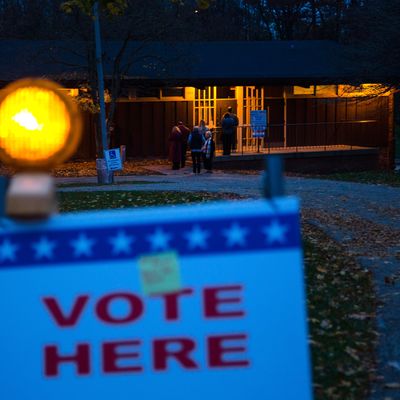
As the clock slowly ticks down toward the next decennial round of congressional and state legislative redistricting after the 2020 census, a federal court decision in Wisconsin could represent the beginning of a whole new regime of judicial supervision of partisan gerrymandering.
The 2-1 decision from a three-judge district court panel is a potential landmark because it adopted a new standard for judging redistricting actions aimed at maximizing partisan advantages, something courts have in the past considered impractical.
At the Washington Post, Kim Soffen explains the case’s potential significance:
Numerous times since the civil rights era, courts have struck down how partisan state legislatures set up legislative districts on the grounds that those decisions diminished the political power of racial minorities. But courts have been far less likely to intervene in cases where states organized voting districts to boost one party, preferring to not get involved in explicitly political matters.
This was why the decision Monday by the federal District Court for the Western District of Wisconsin was so significant. The court found that the Republican-held legislature had intentionally manipulated district lines to favor Republican candidates. And that manipulation was so extreme, it found, that it violated the “one person, one vote” principle and the Democratic voters’ rights to fair representation required by the Constitution’s promises of equal protection.
Federal courts have on occasion questioned partisan gerrymanders that were transparently designed to dilute minority voting rights. But this is a whole new thing. And it seems designed to appeal to one very important Supreme Court justice: Anthony Kennedy, the swing vote in this as in so many other areas of constitutional law, who has kept the door open to challenges to partisan gerrymandering but has never favored one because of the difficulty of measuring the offense or providing a remedy.
In Vieth v. Jubelirer in 2004, four of the justices, in a characteristically vigorous plurality decision by Justice Antonin Scalia, [argued] the issue should be off limits to the courts because there were still no “judicially discernible and manageable standards” for gauging when mapdrawers went too far. Another four justices remained steadfast that the issue was proper one for the courts and proposed various tests for evaluating partisan gerrymander claims. Meanwhile, Justice Anthony Kennedy found himself in the familiar role of the middleman, neither prepared to embrace the tests offered by the other justices nor prepared to join Justice Scalia in saying the issue should be forever banished from the courts. Partisan gerrymandering returned to the high court two years later in LULAC v. Perry. Again, the Court was unable to agree on a standard, leaving the status quo in place.
In the decade since, the issue of partisan gerrymandering has remained largely dormant.
Not anymore. Because of the multi-judge decision, the Wisconsin case could go straight to the Supreme Court. And the decision indeed offers a standard — albeit a novel one — for determining unlawful partisan gerrymanders. It’s called an “efficiency gap” — a measurement of the disproportionate number of votes “wasted” by voters of the disfavored party (in other words, votes that don’t contribute to victory for candidates). The court’s more general objective was to keep the “efficiency gap” from becoming so high that it would effectively entrench the power of the gerrymandering party until the next redistricting cycle almost no matter what actual voters wanted.
As one of the academic originators of the “efficiency gap” explained in a 2014 article, it offers courts a standard similar to the one they already use to determine the compatibility of variations in district size with the one-person, one-vote principle. That seems to be precisely what Anthony Kennedy has been asking for in past SCOTUS cases.
Election law expert Rick Hasen lays out the possible trajectory of the case:
[W]hat happens when this case gets to the Supreme Court? There are four votes (the four liberals) likely to embrace the result in this case, if not necessarily the precise reasoning. There are three Justices (CJ Roberts, and Justices Alito and Thomas) likely to reject the claim in this case as non-justiciable. So to get to a fifth vote there are two possibilities: Justice Kennedy likes what he sees here, in contrast to the other cases where he has waited and rejected other standards, or a new Ninth Justice appointed by President Trump votes for it. How likely is that? Well Trump has promised to appoint someone like Justice Scalia, if that new Justice votes like Scalia, it’s not likely at all. But this is not an issue that necessarily breaks along party lines, and so we will have to see how things go.
So bottom line: this is a big victory for those who want to see courts rein in partisan gerrymandering. But it is anybody’s guess what happens to this when it gets to the Supreme Court.
If Kennedy buys the plaintiff’s argument in this case, we could see not only regular judicial interference with legislative gerrymandering, but a particular benefit to Democrats, who (a) are very likely still to be in the minority in many states after 2020, and (b) have a particular and severe problem with the kind of vote “wastage” the new standard would examine.
Indeed, the partisan implications of the case are so large that the Wisconsin legislature could decide not to appeal the decision, taking a bullet for the national party while keeping SCOTUS from getting the case right away. Who knows? By the time the case makes it to the High Court, perhaps Donald Trump will have reshaped it. But otherwise the days of free-and-easy partisan gerrymandering could be numbered.






























